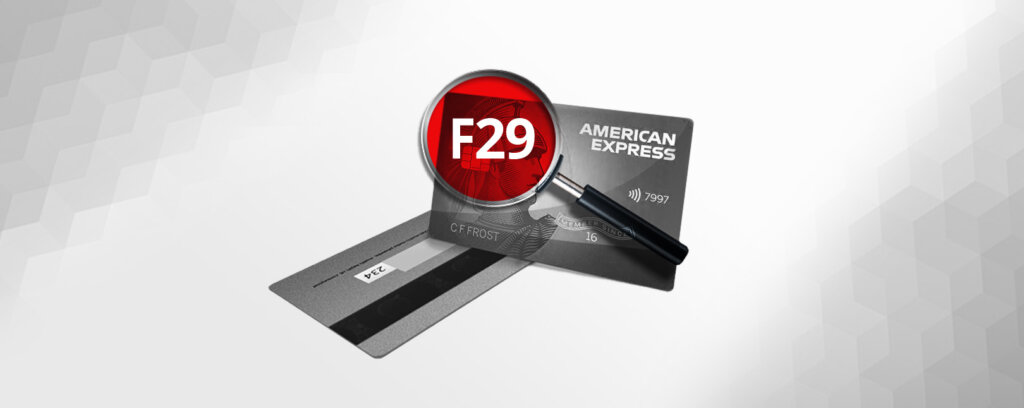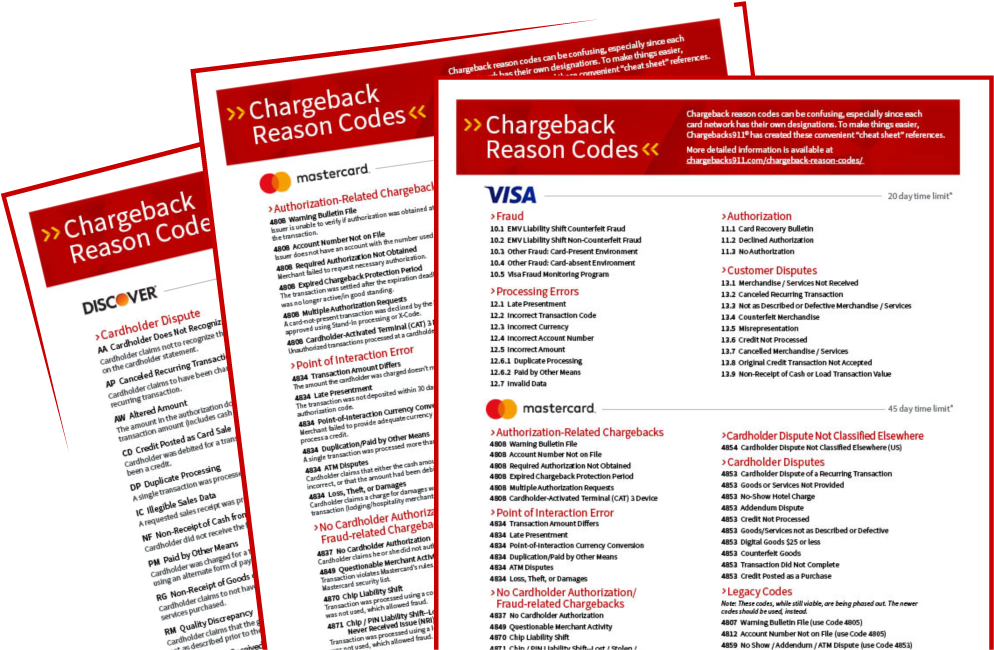
How to Handle Amex Reason Code F29 Chargebacks
American Express breaks down the acceptable causes for a customer to dispute a credit card transaction in their dispute guidelines. This is done for the sake of simplicity and standardization.
Each chargeback trigger has a designated “reason code.” Amex can then assign the appropriate code to each case to show the given reason for the chargeback.
Learn more about Amex reason codes
Today, we’re looking at one reason code in particular — F29 — and exploring the causes, timeframes, fees, and other specifics. We’ll also explore what you can do to prevent these chargebacks from happening.
Recommended reading
- Best Credit Card Processing Companies of 2025 REVEALED
- Chargeback Stats: All the Key Dispute Data Points for 2025
- What Happens When You Dispute a Transaction?
- Economic Uncertainty Pushes Consumers to File Chargebacks
- How Card Cracking Works: Tactics, Red Flags & Prevention
- Charity Backed by Cb911® Featured on FOX13 Tampa Bay
What is American Express Reason Code F29?
American Express chargeback reason code F29 is “Card Not Present.” This reason code is used to explain that a you processed a card-not-present transaction. However, the cardholder objects to the charge.
Chargebacks can be filed using this reason code in response to card-not-present fraud. For example, the buyer claims that they didn’t participate in the transaction.
This reason code can also be used in non-fraud situations, too. For instance, the cardholder may admit to having authorized a charge, but then claim to have never received the goods purchased.
What Caused This Dispute?
Amex Chargeback Reason Code F29 may be issued if a cardholder disputes a card-not-present transaction. Common reason code F29 triggers include:
How to Respond to Amex Reason Code F29 Chargebacks
So, what happens if you can prove that your customer did, in fact, authorize the purchase being challenged?
Naturally, if you get an Amex F29 chargeback, you’ll need to resolve the issue asap. But, let’s say you have a reasonable suspicion that the chargeback was filed without a valid reason for a dispute. If that’s the case, you should file a dispute response. This is done through a process called representment.
Representment means you literally “re-present” the charge to the bank. It’s the process developed specifically to let you fight invalid chargeback claims.
You can’t just resubmit the same transaction data, though; like they say “insanity is doing the same thing over and over again and expecting different results.” This time, you have to provide evidence to the card issuer (in this case, American Express) that the transaction was legit, and that it was in line with all the card issuer's policies.
This is crucial though: remember the time limit.
There’s a strict time limit to consider here. You have just 20 days in which to submit your response to American Express. However, this time frame also includes the time it took for your acquirer to get the dispute notification to you, as well as time spent by the acquirer reviewing and submitting your case. In a real sense, you probably only have five days or less to prepare and submit your response.
There’s a strict time limit to consider here. You have just 20 days in which to submit your response to American Express. However, this time frame also includes the time it took for your acquirer to get the dispute notification to you, as well as time spent by the acquirer reviewing and submitting your case. In a real sense, you probably only have five days or less to prepare and submit your response.
Acceptable Evidence for Amex Reason Code F29 Responses
Think you’ve got a good case? Good. That means you can re-represent the transaction… under the condition that you have solid evidence, of course.
For American Express reason code F29 chargebacks, you’ll need to produce documentation that proves the buyer’s claim is invalid. This may include:
- Delivery confirmation showing that the goods purchased were delivered to the cardholder.
- Proof of no (or “unchecked”) response to attempt to validate the card security code.
- Record of a credit already provided to the buyer that offsets the disputed charge.
- Record of the shipping information provided by the buyer, which matches shipping information provided by the same buyer for a transaction that was not disputed.

Additional Documentation Requirements
Depending on the transaction type, American Express may require additional pieces of documentation for a chargeback response. These requirements are outlined below.
How to Prevent Amex Reason Code F29 Chargebacks
As the old adage goes, “an ounce of prevention is worth a pound of cure.”
You may never be able to stop chargebacks entirely. But, you can limit your exposure to risk and keep your chargeback ratio in good standing by adopting a few best practices. You’re going to want to:
#1 | Get Consent
Before charging the customer’s card, make sure you have express consent to bill the buyer for the goods or services provided.
#2 | Keep Good Records
Make sure you have documentation on file tying the consent provided to the goods or services, as well as your terms and conditions.
#3 | Optimize Your Descriptors
Your billing descriptor is the indicator that shows up on your customers’ credit card statements. Ensure that it includes your “doing business as” (or “DBA”) name, as well as your website. This will help cardholders identify charges.
#4 | Include a Phone Number
Adding your customer service contact number to your billing descriptor means that customers can contact you directly to ask about purchases (rather than calling the bank to file a chargeback).
#5 | Add Special Conditions
If there’s a special condition that applies — for example, a “no show” charge” or an installment number — make sure that these show up in the charge descriptor. That way, the buyer doesn’t assume they’re being double-charged.
#6 | Develop & Deploy a Fraud Detection Strategy
One or two fraud tools won’t cut it. You need a multilayer strategy, involving multiple tools and redundancies to detect fraud before it happens.
Take a Wider View
You can dispute invalid chargebacks from Amex reason code F29. However, it’s much more efficient to take a proactive stance. The same is true of the other chargeback reason codes, as well. A truly effective chargeback management strategy must encompass prevention as well as disputing cases of friendly fraud.
Chargebacks911® can help your business manage all aspects of chargeback reason codes, with proprietary technologies and experience-based expertise. Contact us today for a free ROI analysis to learn how much more you could save.
FAQs
Does Amex investigate chargebacks?
Yes. American Express investigates chargebacks by reviewing the evidence provided by both the merchant and the cardholder to determine the legitimacy of the transaction and decide on the chargeback claim. This process ensures a fair resolution based on the documentation and arguments presented by both parties.
What is the reason code for a chargeback on American Express card?
An American Express chargeback reason code is a code that identifies the specific reason a cardholder or issuing bank has disputed a transaction, guiding the merchant on the nature of the dispute and what evidence may be required to contest it. Each code corresponds to a particular issue, such as unauthorized use, processing errors, or non-receipt of goods or services. Click here to see a full list of Amex reason codes.
Do police investigate chargebacks?
Police typically do not investigate chargebacks as they are considered a dispute between the merchant and the cardholder, handled through the card issuer's internal processes. However, if fraud is suspected as the cause of a chargeback, law enforcement may be involved in investigating the fraudulent activities.
How successful are Amex disputes?
The success of an American Express dispute depends on the merchant's ability to provide compelling evidence that the transaction was valid and in accordance with Amex policies. Success rates vary widely based on the nature of the dispute and the quality of the documentation provided by the merchant.
How does American Express investigate disputes?
American Express investigates disputes by reviewing documentation and evidence provided by both the cardholder and the merchant, such as transaction receipts, proof of delivery, or communication records, to determine the validity of the chargeback claim. This process aims to ensure a fair resolution based on the facts presented by both parties.











